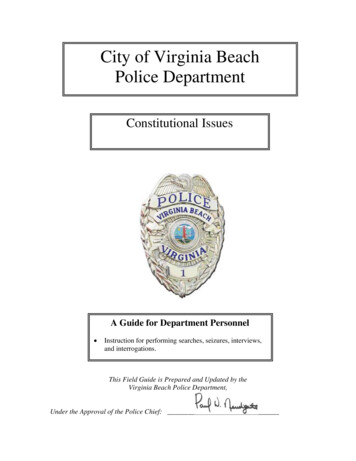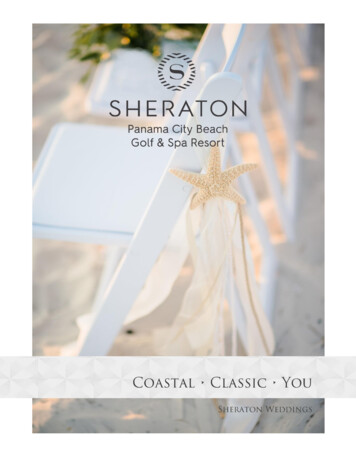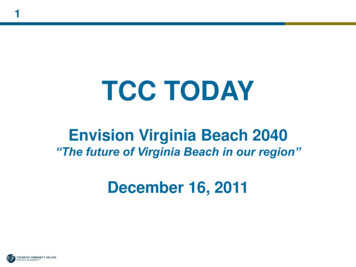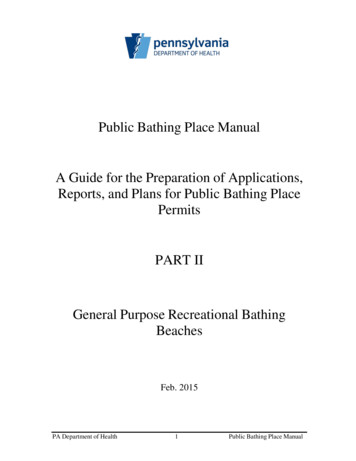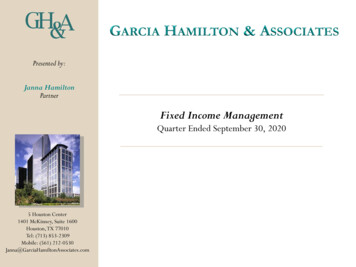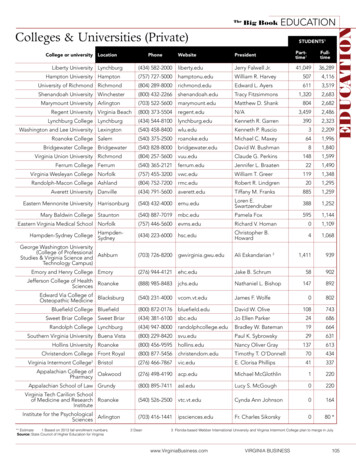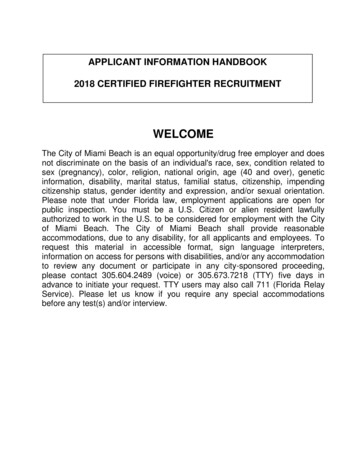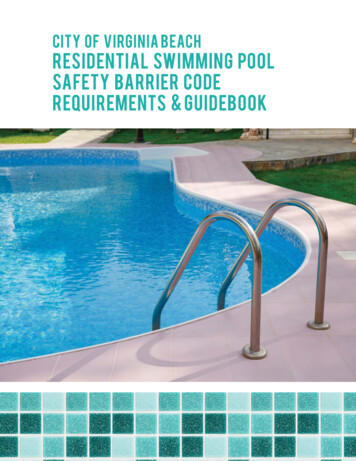
Transcription
City of Virginia beachResidential swimming poolSafety barrier CodeRequirements & Guidebook
This document has been adapted from the U.S. Consumer Product Safety Commission’sSafety Barrier Guidelines for Residential Pools and modi ied for the City of Virginia Beach.For more information, contact:City of Virginia Beach Department of Housing & Neighborhood PreservationCode Enforcement Division2424 Courthouse Drive, Bldg. 18AVirginia Beach, VA 23456(757) ment08/2016
IntroductionThe City of Virginia Beach is committed to ensuring a safe environment for all residentsand visitors. Owners of swimming pools, spas and hot tubs have special responsibilities tohelp ensure a safe environment by complying with state and city codes intended to preventaccess to swimming pools, spas and hot tubs by children.The City of Virginia Beach enforces the Virginia Uniform Statewide Building Code and othercity codes, which contain provisions for the construction and installation of new swimmingpools and barriers, and provisions for the maintenance of existing swimming pools andbarriers. This guidebook provides information and diagrams to help ensure owners ofswimming pools, spas and hot tubs are in compliance with the city and state codes.Your attention to the information in this brochure and the permit requirements forswimming pools will help prevent deaths by drowning. Thank you for being part of makingVirginia Beach safe!DisclaimerThis guide is for informational purposes only. All property owners must obtain a permitfor the installation of swimming pools and barriers. Use of the information in this guideis not a substitute for a permit. The City of Virginia Beach cannot be held liable for anyaction taken as a result of this brochure.For information on new pool and barrier installations and permits:Contact the Permits and Inspections Division of the Department of Planning and CommunityDevelopment at (757) 385-4211 or visit www.vbgov.com/permits.For concerns regarding existing pools and barriers:Contact the Code Enforcement Division of the Department of Housing and NeighborhoodPreservation at (757) 385-4421 or visit www.vbgov.com/codeenforcement.
There are two basic steps required to prevent drowning deaths inswimming pools:1.Create barriers to prevent access by young children. The types of barriers that canbe used depend on speci ic pool designs, and are regulated by state and city code.2.Never leave children unattended where they can gain access to pools, even for veryshort periods of time. Drowning can occur very quickly. Don’t be the victim of aterrible tragedy!BarriersAn effective pool barrier prevents a child from going OVER, UNDERor THROUGH the barrier and keeps children from accessing thepool when supervising adults are not present.Barriers include a fence or wall, door alarms for the house, and/or a power safety cover overthe pool. Barriers are not childproof, but barriers do provide layers of protection for a childwhen there is a lapse in adult supervision. Barriers give parents additional time to ind achild before the unexpected can occur.LocationsBarriers must be located to prevent children from using permanent structures, equipment,or similar objects to climb the barriers.ConstructionA barrier that completely surrounds the pool is better than a fence that encloses the poolon three sides with the house serving as the fourth side of the barrier. Fences must be aminimum of 4 feet high. However, fences 5 feet or higher are preferable.If an outside wall of the home serves as one side of the barrier, all doors, door screens andoperable windows with a sill height of less than 48 inches that lead to the pool area musthave alarms installed. Make sure the doors have self-closing and self-latching devices orlocks that are beyond the reach of children. This will keep children from opening the doorsand gaining access to the pool.Pool covers add another layer of protection. There are a wide variety of pool cover styleson the market. Make sure that the pool cover is well maintained, and keep the control devicefor the pool cover out of the reach of children.City of Virginia beach Residential swimming pool safety barrier CODE REQUIREMENTS & GUIDEBOOK2
How to Prevent a Child from Going OVER a Pool BarrierA young child can climb over a pool barrierif the barrier is too low or if the barrier hashandholds or footholds that children can useto climb. The top of a pool barrier must be atleast 48 inches above grade, measured on theexterior side of the fence or barrier.Figure 1Figure 2Eliminate handholds and footholds on barriers and minimize the size of openings whenconstructing a barrier. Make sure that there are no indentations or protrusions on thebarrier that may allow a child to climb over the barrier.For a Barrier with Horizontal and VerticalMembersIf the distance between the top side of the horizontalmembers of the barrier or fence is less than 45 inches high,then the horizontal members must be located on the interiorside of the fence.The spacing between vertical members and withindecorative cutouts shall not exceed 1¾ inches. This size isbased on the foot width of a young child and is intended toreduce the potential for a child to gain a foothold and attemptto climb the barrier.Figure 3City of Virginia beach Residential swimming pool safety barrier CODE REQUIREMENTS & GUIDEBOOK3
If the distance between the tops of the horizontal membersis more than 45 inches high, the horizontal members canbe located on the exterior side of the fence. The spacingbetween vertical members shall not exceed 4 inches. Thissize is based on the head breadth and chest depth of a youngchild and is intended to prevent a child from passing throughor getting stuck in an opening.For a Chain-Link FenceThe openings in the mesh of a chain-link fence shall notexceed 1¾ inches square unless slats, fastened at the top orbottom of the fence, are used to reduce the mesh openings tono more than 1¾ inches.Figure 41¾Figure 5Figure 6For a Fence with Diagonal Members orLatticeworkThe maximum opening in the latticework shall not exceed1¾ inches.Figure 7City of Virginia beach Residential swimming pool safety barrier CODE REQUIREMENTS & GUIDEBOOK4
Above-Ground PoolsAbove-ground pools must have barriers. The pool structure can serve as a barrier if thewalls of the pool are high enough, or if a barrier can be mounted onto the top of the poolstructure.Figure 8bFigure 8aFigure 8cIf the pool walls are not high enough, or there are other structures close to the pool, suchas a ladder or a table or a chair, often children are able to access the pool. There are waysto prevent young children from climbing and gaining access to an above-ground pool. Thesteps or ladder leading to the pool can be designed to be secured, locked or removed toprevent access; or the steps or ladder can be surrounded by a barrier, such as the barriersdescribed in these guidelines.Above-Ground Pool with Barrier on Top of PoolIf an above-ground pool has a barrier on top of the pool, themaximum vertical clearance between the top of the pool and thebottom of the barrier shall not exceed 4 inches.Mesh fences shall not be used on top of an above-groundresidential pool.Figure 9City of Virginia beach Residential swimming pool safety barrier CODE REQUIREMENTS & GUIDEBOOK5
How to Prevent a Child from GoingUNDER a Pool BarrierFor any pool barrier, the maximum clearance at the bottomof the barrier shall not exceed 4 inches above the surfaceor ground, when the measurement is done on the outsideof the barrier. If the bottom of the gate or fence rests on anon-solid surface, such as grass, sand or gravel/pebbles,the clearance shall not exceed 2 inches.CementFigure 10Non-solid surface (i.e.grass, sand or gravel/pebbles)How to Prevent a Child from GoingTHROUGH a Pool BarrierTo prevent a child from going through a pool barrier,restrict the size of openings in the barrier, and use selfclosing and self-latching gates.To prevent a young child from going through a fence orother barrier, make sure all openings in the barrier aresmall enough to prevent a 4-inch diameter sphere frompassing through any opening. This size is based on the headbreadth and chest depth of a young child.Figure 11Portable pools are becoming more popular. Portable pools vary in size andheight, from tiny blow-up pools to larger designs that can hold thousands ofgallons of water. Portable pools present a real danger to young children.Never leave children around a portable pool unsupervised. Portable poolsmust be fenced, covered or emptied and stored away when not in use. Tellneighbors, friends and caregivers that you have a portable pool and advisethem of the potential dangers of a portable pool in your yard.City of Virginia beach Residential swimming pool safety barrier CODE REQUIREMENTS & GUIDEBOOK6
Removable Mesh FencesMesh fences are made speci ically for swimming pools or other small bodies of water.Although mesh fences are meant to be removable, the safest mesh fences for pools arelocked into the pool deck so that the fence cannot be removed without extensive use of tools.Like other pool fences, mesh fences must be a minimum of 48 inches in height. The distancebetween vertical support poles and the attached mesh, along with other manufacturedfeatures, shall be designed to keep a child from climbing the fence. The bottom of the meshbarrier shall not be more than 1 inch above the deck or installed surface.For more information on Removable Mesh Fencing see ASTM standard F 2286 – 05 or themanufacturer’s installation instructions.GatesThere are several kinds of gates that might be found on a residentialproperty: pedestrian, utility, services or vehicle gates. Gates canbe used as a swimming pool barrier. All gates must be designed toaccommodate a locking device.Pedestrian GatesThese are gates people walk through to access the swimming pool. Figure 12Swimming pool barriers must be equipped with one or more gates that have the properlocks or hardware installed to restrict access to the pool.Gates shall open out from the pool and shall be self-closingand have a self-latching device.When the release mechanism of the self-latching deviceon the gate is less than 54 inches from the bottom of thegate, the release mechanism for the gate must be at least3 inches below the top of the gate on the interior side.Placing the release mechanism at this height preventsa young child from reaching over the top of a gate andreleasing the latch.Figure 13Additionally, the gate and barrier must have no openinggreater than ½ inch within 18 inches of the latch-releasemechanism. This prevents a young child from reachingthrough the gate and releasing the latch.City of Virginia beach Residential swimming pool safety barrier CODE REQUIREMENTS & GUIDEBOOK7
The weakest link in the strongest and highest fence is a gate that fails toclose and latch completely. For a gate to close completely every time, the gatemust be in proper working order.All Other GatesGates, other than pedestrian gates, shall be kept locked when not in use.When One Side of the House Forms Part of the PoolBarrierIn many homes, doors open directly from the house to the pool area or to a patio leading tothe pool. In these cases, the side of the house that leads to the pool is an important part ofthe pool barrier. Passage through any door from the house to the pool must be controlled bysecurity measures.Door AlarmsAll doors and operable windows with a sill height of less than 48 inches that allow accessto a swimming pool shall be equipped with an audible alarm that sounds when the door orits screen or window is opened. Alarms shall meet the requirements of UL 2017, GeneralPurpose Signaling Devices and Systems, Section 77, and have the following features: The alarm sound must last for 30 seconds or more andstart within 7 seconds after the door is opened.The alarm must be loud: at least 85 dB (decibels), whenmeasured 10 feet away from the alarm mechanism.The alarm sound must be distinct from other sounds inthe house, such as the telephone, doorbell, and smokealarm.The alarm must have an automatic reset feature todeactivate the alarm temporarily for up to 15 seconds, toallow adults to pass through house doors without settingoff the alarm. The deactivation switch could be a touchpad(keypad), or a manual switch, and must be located at least54 inches above the threshold and out of the reach ofchildren.Figure 14City of Virginia beach Residential swimming pool safety barrier CODE REQUIREMENTS & GUIDEBOOK8
Pet or Doggy DoorsPet or doggy doors should not be installed on doors that lead directly toa pool or other backyard water. An isolation barrier or fence is the bestdefense when pet doors are installed. Remember, pet door openings, oftenoverlooked by adults, provide curious children with access to backyardadventures. Locking these doors is not suf icient and could lead to accidentsand tragedies. Children regularly drown in backyard pools that they wereable to access through pet doors.Power Safety CoversPower safety covers can be installed on pools to provide security barriers, especially whenone side of the house serves as the fourth wall or side of a barrier. Power safety coversmust conform to the speci ications in the ASTM F 1346-91 standard, which speci ies safetyperformance requirements for pool covers to protect young children from drowning.Other Means of ProtectionSelf-closing doors with self-latching devices can be used in place of alarms and approvedcovers when they provide the same level of protection.Indoor PoolsWhen a pool is located completely inside a house, the walls thatsurround the pool must be equipped to serve as pool safetybarriers. Guidelines recommended for using door alarms, poolalarms and covers where the house wall serves as part of a safetybarrier also apply for all the walls surrounding an indoor pool.Figure 15City of Virginia beach Residential swimming pool safety barrier CODE REQUIREMENTS & GUIDEBOOK9
SUMMARY OF pool safety barrier requirementsIn accordance with state and city codes, all outdoor swimming pools, including in-ground,above-ground and on-ground pools, hot tubs and spas shall have a barrier that complieswith the following, irrespective of the date of construction:1.The top of the barrier shall be at least 48 inches above the surface measured on theexterior side of the barrier (ϔigure 1).2.The maximum vertical clearance between the surface and the bottom of thebarrier shall be 4 inches, measured on the exterior side of the barrier. In the case ofa non-solid surface, such as grass, sand or gravel/pebbles, the distance shall bereduced to 2 inches, and 1 inch for removable mesh fences (ϔigures 1 and 10).3.Where the top of the pool structure is above grade or surface, such as an aboveground pool, the barrier may be at ground level, like the pool structure, or mountedon top of the pool structure. Where the barrier is mounted on top of the poolstructure, the maximum vertical clearance between the top of the pool structure andthe bottom of the barrier shall be 4 inches (ϔigure 9).4.Openings in the barrier shall not allow passage of a 4-inch diameter sphere (ϔigure11).5.Solid barriers, which do not have openings, such as masonry or stone walls, shallnot contain indentations or protrusions that may allow a child to climb over thebarrier (ϔigure 2).6.Where the barrier is composed of horizontal and vertical members, and thedistance between the bottom and top horizontal members is less than 45 inches, thehorizontal members shall be located on the interior side of the fence (ϔigure 3).7.Spacing between vertical members shall not exceed 1¾ inches in width. Wherethere are decorative cutouts, spacing within the cutouts shall not exceed 1¾ inchesin width (ϔigures 3 and 4).8.Maximum mesh size for chain link fences shall not exceed 1¾ inch square, unlessthe fence is provided with slats fastened at the top or the bottom that reduce theopenings to no more than 1¾ inches (ϔigures 5 and 6).9.Where the barrier is composed of diagonal members, such as a lattice fence, themaximum opening formed by the diagonal members shall be no more than 1¾inches (ϔigure 7).City of Virginia beach Residential swimming pool safety barrier CODE REQUIREMENTS & GUIDEBOOK10
10.Access gates to the pool shall be equipped to accommodate a locking device.Pedestrian access gates shall open outward, away from the pool, and shall be selfclosing and have a self-latching device (ϔigure 12). Gates other than pedestrianaccess gates shall remain locked when not in use. Where the release mechanism ofthe self-latching device is located less than 54 inches from the bottom of the gate,a. the release mechanism shall be located on the interior side of the gate, atleast 3 inches below the top of the gate; andb. the gate and barrier shall have no opening greater than ½ inch within 18inches of the release mechanism (ϔigure 13).c. Access gates must remain closed at all times when the pool is not inuse.11.Where a wall of a dwelling serves as part of the barrier, one of the following shallapply:a. All doors and operable windows with a sill height of less than 48inches that provide direct access to the pool shall be equipped withan approved alarm that produces an audible warning when the doorand its screen, if present, or window are opened. Alarms shall meet therequirements of UL 2017, General-Purpose Signaling Devices and Systems,Section 77.b. The pool shall be equipped with an approved power safety cover thatcomplies with ASTM F1346-91, listed on page 12.c. Other means of protection, such as self-closing doors with self-latchingdevices, are acceptable, as long as the degree of protection afforded is notless than the protection afforded by (a) or (b), described above.12.Where an above-ground pool structure is used as a barrier, or where the barrieris mounted on top of the pool structure, and the means of access is a ladder or steps(ϔigure 8a), thena. the ladder to the pool or steps shall be capable of being secured, locked orremoved to prevent access (ϔigure 8b); orb. the ladder or steps shall be surrounded by a barrier, such as thebarriers described in this guidebook (ϔigure 8c). When the ladder orsteps are secured, locked or removed, any opening created shall not allowthe passage of a 4-inch diameter sphere.Pool maintenanceImproperly maintained swimming pools can provide a breeding ground for mosquitoes,which can spread disease. Be sure to maintain your swimming pools and iltration systemsto prevent mosquito infestations during the warmer months.City of Virginia beach Residential swimming pool safety barrier CODE REQUIREMENTS & GUIDEBOOK11
Fencing: ASTM F 1908-08 Standard Guide for Fences for Residential Outdoor Swimming Pools,Hot Tubs, and Spas: www.astm.org/Standards/F1908.htm ASTM F 2286-05 Standard Design and Performance Speciϔications for Removable MeshFencing for Swimming Pools, Hot Tubs, and Spas: www.astm.org/Standards/F2286.htmCovers: ASTM F 1346-91 Standard Performance Speciϔication for Safety Covers and LabelingRequirements for All Covers for Swimming Pools, Spas and Hot Tubs:www.astm.org/Standards/F1346.htmNote: ASTM Standards are available for a fee. You may want to contact a pool contractor.Standards: ASTM Standards: Contact ASTM online at www.astm.org/CONTACT/index.html UL (Underwriters Laboratories) Relevant Pool and Spa Standards: www.ul.com. Lookfor Life Safety and Security ProductRelated CodesVirginia Maintenance Codes Section 303.1: Overall Condition of Pool Section 303.2: Pool Enclosures/BarriersCity Codes Section 23-46: Nuisance Generally Section 34-35: Closure of Swimming Pool Gates Section 34-36: Swimming Pool FencesContactsCode Enforcement(757) mentPermits and Inspections(757) y of Virginia beach Residential swimming pool safety barrier CODE REQUIREMENTS & GUIDEBOOK12
The U.S. Consumer Product Safety Commission Pool Safely:Simple Steps Save Lives campaign provides advice and tipson drowning and entrapment prevention. Installing barriers isjust one of the Pool Safely Simple Steps for keeping children safearound all pools and spas. Here are others:Rule # 1: Never leave a child unattended arounda pool, spa, bath tub or other body of water.At pools, spas and other recreational waters: Teach children basic water safety skills. Learn how to swim and make sure your children know how to swim. Avoid entrapment accidents by keeping children away from pool drains, pipes andother openings. Have a phone nearby at all times when visiting a pool or spa. Know the address of your location so that you can direct emergency personnel to thescene, if needed. If a child is missing, look for the child in the pool or spa irst, including neighbors’ poolsor spas. Share safety instructions with family, friends, babysitters and neighbors.If you have a pool: Install a 4-foot non-climbable fence around the perimeter of the pool and spa, includingportable pools. Use self-closing and self-latching gates. Ask neighbors to do the same if they have poolsor spas. If the house serves as the fourth side of a fence around a pool, install and use a door orpool alarm and/or a pool or spa cover. Maintain pool and spa covers in good working order. Ensure that any pool or spa that you use has anti-entrapment safety drain covers. Askyour pool service representative if you do not know.* Have life-saving equipment—such as life rings, loats or a reaching pole—available andeasily accessible.*The Virginia Graeme Baker Pool & Spa Safety Act, a federal law, requires all public pools and spas tohave anti-entrapment drain covers and other devices, where needed. Residential pools are not requiredto install these, but they are highly recommended.Visit www.PoolSafely.gov for more information. See the most recent CPSC submersionreports: Submersions Related to Non-Pool and Non-Spa Products, 2012 and Pool or SpaSubmersion Report, 2015.
Mesh fences are made speciically for swimming pools or other small bodies of water. Although mesh fences are meant to be removable, the safest mesh fences for pools are locked into the pool deck so that the fence cannot be removed without extensive use of tools. Like other pool fences, mesh fences must be a minimum of 48 inches in height.
